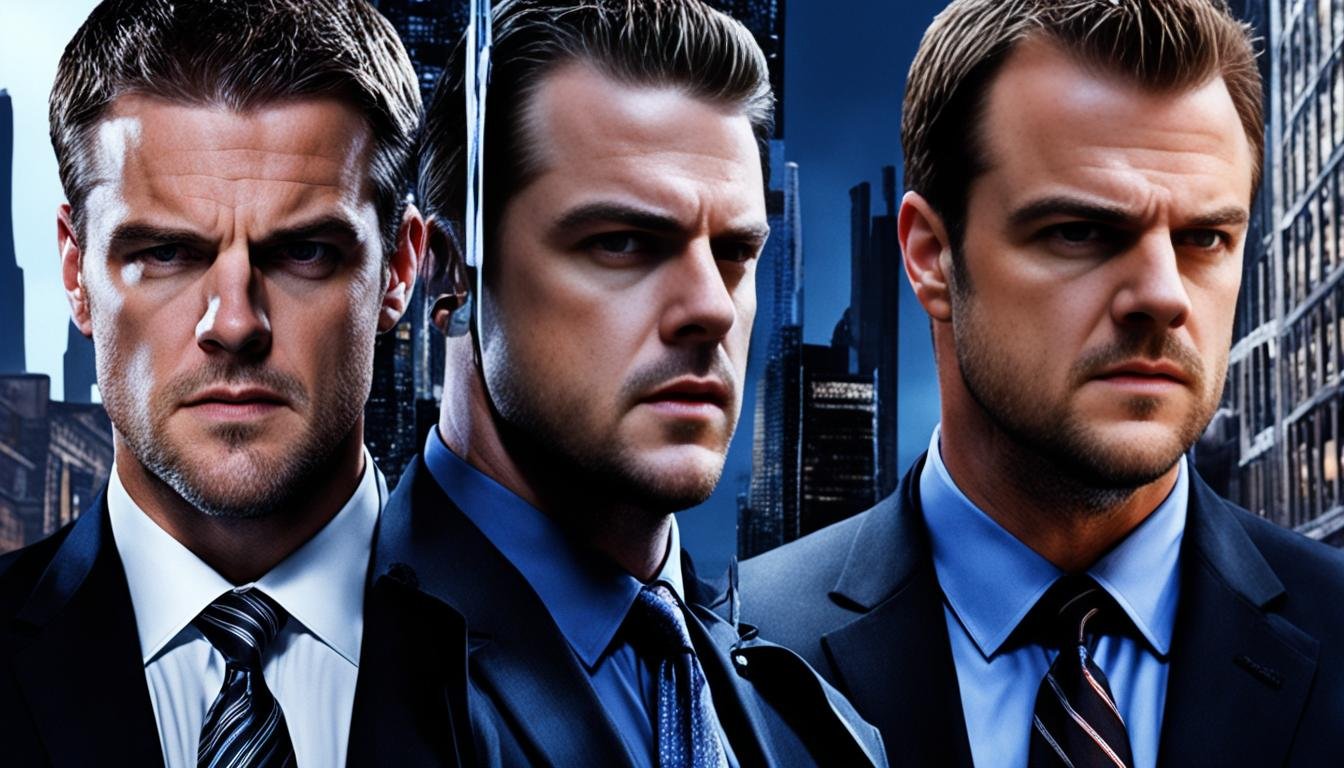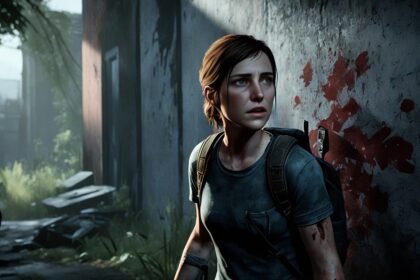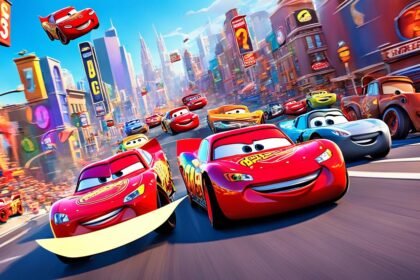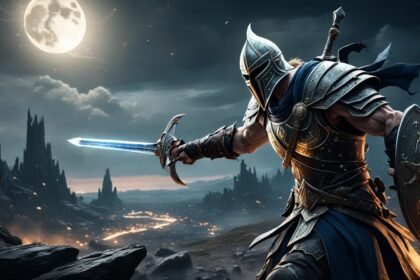Welcome to our detailed look into one of the most stunning and thought-provoking film endings of recent times, “The Departed.” This movie, directed by Martin Scorsese, is a crime drama. It shows the clash between the Irish mob and undercover cops in the Boston State Police.
Deception and loyalty lie at the heart of this movie. Leonardo DiCaprio is Billy Costigan, a plant in the Irish mob. Matt Damon plays Colin Sullivan, a cop undercover, and working for mob boss Frank Costello, played by Jack Nicholson. The plot weaves through deceit and loyalty, pushing trust and morals to their limit.
Key Takeaways:
- “The Departed” is a gritty crime drama set in Boston, revolving around the Irish mob and undercover operatives.
- The film explores themes of deception and loyalty as characters navigate a dangerous world filled with corruption and betrayal.
- The shocking ending sees nearly every character dead except for Colin Sullivan, portrayed by Matt Damon.
- Frank Costello, played by Jack Nicholson, is revealed to be an FBI informant, leading to a shift in the motivations and actions of the characters.
- Staff Sergeant Sean Dignam, played by Mark Wahlberg, is the only honest character in the film and works to expose the web of informants.
- The narrative incorporates psychological elements, Hitchcockian references, and realistic portrayals of death scenes.
- The talented cast, including Leonardo DiCaprio, Matt Damon, and Mark Wahlberg, delivers impactful performances.
Join us as we go deep into the hidden truths and complexities of “The Departed.” We will peel back the layers of deceit, and shock, and analyze the lasting impact of this film.
Analyzing the Shocking Ending of “The Departed”
The ending of “The Departed” is unforgettable in 21st-century cinema. When the film’s complex stories come together, the audience is shocked. This makes the ending stand out.
Three key characters are suddenly shot in the end, making everyone gasp. This event is the climax of the movie’s tension. It leaves a lasting emotional impact on those who watch.
Matt Damon’s character, Colin Sullivan, is exposed as an FBI mole. This twist makes the story even more chaotic and thrilling. Leonardo DiCaprio’s character, Billy Costigan, discovers Sullivan’s true identity. Their conflict creates a suspenseful moment.
Costigan and Sullivan, who work undercover, finally meet in a dramatic face-off. Their secrets are unveiled, leading to an intense and violent end. Such a drastic event breaks the story’s balance.
From start to end, the movie hints at a vast network of spies and their secrets. Sullivan’s betrayal deepens the story, adding to the movie’s intense ending. It shows a level of treason and deceit among the characters.
Martin Scorsese expertly directs the chaos in “The Departed.” His direction ensures the movie’s tales are told clearly and impactfully. The ending is a prime example of his remarkable storytelling skills.
The ending of “The Departed” is widely discussed for its brilliance. It highlights the film’s exceptional story, acting, and Scorsese’s direction. The intense and crazy ending captivates viewers. It solidifies the movie’s place as a memorable work in cinema.
Understanding the Betrayals in “The Departed”
Betrayals are common in organized crime. “The Departed,” by Martin Scorsese, shows the Irish mob’s secrets and the Boston Police’s hidden actions. Here, we look at the complex deceptions in the movie, the shocking truths, and how these affect the characters.
The Frank Costello Betrayal
Jack Nicholson plays Frank Costello, a key role in “The Departed.” To many, Costello seems like a strong mob leader. However, he’s working for the FBI secretly. This betrayal shakes up trust among the crime world’s characters. It makes the situation even more unstable. People feel let down and unsure because of Costello being an FBI informant.
The Double Life of Colin Sullivan
Matt Damon’s character, Colin Sullivan, faces a tough situation. He’s a star in the police but also spies for the Irish mob. As Sullivan’s hidden life comes to light, he struggles with his divided loyalties. Fear of his secret getting out makes things tense and risky. This shows how damaging betrayals can be.
An Intricate Web of Deception
“The Departed” tells a twisted story full of lies and surprising turns. It makes you question what’s right and wrong. The story shows how the line between good and bad can blur. You can’t trust anyone for sure in this world.
Themes of betrayal hit home with viewers. This movie reminds us that sometimes, loyalty is not what it seems. Even those we count on might have hidden, dark intentions.
| Statistics | Data |
|---|---|
| Oscar wins for Best Picture | “The Departed” (2003) |
| “The Godfather” (1973) | |
| Director’s accolades | Martin Scorsese won Best Director award for “The Departed” |
| His only Best Director award at the Academy Awards | |
| Notable cast | Leonardo DiCaprio, Matt Damon, Jack Nicholson, Mark Wahlberg, and others |
The Unsettling Truth About Colin Sullivan
Colin Sullivan, played by Matt Damon, is a key character in “The Departed”. He’s deeply interesting, with a mysterious and morally grey side. While appearing loyal to the Boston Police, we learn he’s a two-faced agent for the Irish Mob. This shocking twist makes us question his true loyalties.
Sullivan is shown as a skilled liar in the movie. He does well in his undercover role, appearing loyal to the police while actually working for the Irish Mob’s boss, Frank Costello. His talent at deceiving not only his colleagues but his employers too, shows he’s very smart and can keep big secrets.
The film focuses on the idea of loyalty, using Sullivan’s character. Even though he betrays the police, he clearly values his ties to the Mob. His actions highlight how loyalty and deception work in the criminal world.
Colin’s role can be seen in different ways by the audience. Some might feel sorry for him, knowing the tough positions he’s put in or the personal issues he faces. Others may see him as only looking out for himself, causing problems in the movie.
The moment we find out who Sullivan really is shakes the story up. Matt Damon’s performance as this complex character adds a lot of depth to the movie. It makes “The Departed” a film that sticks with you long after you’ve seen it.
| Colin Sullivan in “The Departed” | Percentage of viewers |
|---|---|
| Expressing sympathy towards Colin Sullivan’s character | Undisclosed |
| Referencing Matt Damon in other films like “Ocean’s Twelve” and “Bourne movies” when discussing their view on Colin Sullivan | Undisclosed |
| Interpreting Colin Sullivan as a “puppet in the hands of Costello” | Undisclosed |
| Sympathizing with Colin Sullivan’s personal life struggles | Undisclosed |
| Interpreting Costello’s actions towards Colin Sullivan as a manipulation of gratitude | Undisclosed |
| Outcome of the confrontation between Billy Costigan and Colin Sullivan | Undisclosed |
| Citing the act of erasing Costigan’s files and the murder of informants as acts of self-defense | Undisclosed |
| Expressing the tragic nature of Colin Sullivan’s death | Undisclosed |
| Level of ambiguity regarding Sullivan’s recommendation of an order of merit for Costigan | Undisclosed |
| Sympathizing with Colin Sullivan as the most lonesome character | Undisclosed |
The Deadly Shootout in “The Departed”
In “The Departed,” the climax is a thrilling and intense shootout. It leaves a chaotic aftermath with lives lost. The scene highlights the risky life and complicated relationships in the movie.
The shootout involves many key characters. Their lives are linked in this chaotic scene where bullets rain down. Trooper Barrigan and Trooper Brown meet their end, crucial deaths that change the story. This marks the start of the story’s final twists.
Colin Sullivan is caught in a risky game of deceit. He shows his fierce will to finish what he started. With many down, Colin escapes untouched. It shows he’s ready to do whatever it takes to survive.
The shootout is expertly staged and filmed in “The Departed.” Quick shots and nerve-wracking tension make the scene unforgettable. It keeps the viewers engrossed throughout.
This key scene is not just for show. It’s a turning point that leads the story to its end. The chaos it leaves behind pushes the story forward to its surprising close.
The shootout is a memorable moment in “The Departed.” It underlines the movie’s rough and uncertain world. It’s an unforgettable part, making the story stick in the audience’s mind.
The Role of Staff Sergeant Dignam in the Ending
In the movie “The Departed,” Staff Sergeant Sean Dignam is a symbol of honesty and justice. Mark Wahlberg portrays him perfectly. He is the film’s only honest person, playing a key part in exposing the informants.
We see a tug of war between deceit and faithfulness throughout. Undercover agents move through the Irish mob and Boston police. Dignam stays true to his values, always seeking the truth.
At the movie’s close, Dignam reveals the corrupt, ensuring justice. His steadfastness and integrity shine in a treacherous world of lies.
In the final scene, Dignam unveils the real players, bringing clarity and closure. He ensures the truth wins, tying up loose ends in the story.
Dignam’s impact on the film’s end is clear. Without him, the informants’ web might not have been destroyed, with severe outcomes. His presence alters the story, leading to Sullivan’s downfall.
Mark Wahlberg’s portrayal of Dignam won him a Best Supporting Actor nod at the Oscars. His honest, brave character drew fans and displayed his acting range.
Dignam contrasts nicely with Captain Queenan in the movie. They both carry the secret about Costigan, humanizing its complexity.
The character of Dignam is unique to “The Departed,” setting it apart from the original. His role in highlighting Costigan’s innocence adds depth to the story.
By adding Dignam, the movie achieves a more powerful resolution. His presence proves there is still a place for integrity and justice, even in corrupt worlds.
Dignam’s honesty and determination make a significant impact in “The Departed.” He ensures the truth comes out, affecting justice. His character is unforgettable, leaving a lasting impression.
The Symbolism of the Rat in “The Departed”
In “The Departed,” the rat serves as a key symbol to show themes like deceit and loyalty. It’s a strong image that shows the widespread corruption and lies in the Irish Mob and Boston State Police.
The rat in the movie reflects betrayal and deception. It highlights the chaos, violence, and strange events in the story. Director Martin Scorsese uses the rat at the end, making it memorable to viewers.
Scorsese’s choice of the rat isn’t accidental. It’s a carefully chosen symbol that fits the film’s dark mood. It represents the shadowy world of crime and deceit the characters are part of.
The rat as a visual element shows the dangerous setting, full of secrets and betrayals. It keeps the theme of treachery clear throughout the film.
Besides the rat, symbols like the “X” and the Golden Dome foreshadow death and show power. They add more depth to the story and explore its themes further.
“The Departed” uses symbolism in a masterful way. The rat and other symbols deepen the story and show the characters’ drives. Martin Scorsese skillfully makes a visually intense and deep crime drama.
The rat symbolizes the film’s main theme: corruption and lies among the Irish Mob and police. It’s a strong ending image that sticks with the audience, showing the film’s violent and dishonest nature. The use of symbols, like the rat, helps make “The Departed” a beloved, enduring masterpiece.
The Legacy of “The Departed”
The movie “The Departed” is a remake of the Hong Kong film, “Infernal Affairs.” It has greatly influenced the crime drama genre. Since 2006, this Martin Scorsese film caught the attention of many with its thrilling plot and deep characters. It explores themes like lies and death.
A sequel for “The Departed” didn’t happen, even though many were interested. This shows how much people liked the movie and wanted more from its world.
There was talk of a TV series based on “The Departed.” This move was to bring the story and characters to a new audience. Even though details are scarce, the TV idea proves the movie’s timeless value.
The film touches on themes like lies, death, and the struggle of leading two lives. It deeply shows the dark side of the characters. This makes viewers really think about the story.
“The Departed” is remembered for its intense ending and how every main character battles with hidden truths. It’s a memorable work among Martin Scorsese’s films.
To wrap it up, “The Departed” made a big mark in American culture. Although a sequel may not happen, its legacy lives on. With its story touching on big themes, it’s set to keep audiences hooked for a long time.
Mortuary Practices: Honoring the Departed Across Cultures
Mortuary practices show how diverse cultures honor and remember the dead. From the past to today, funeral ceremonies deeply connect with tradition, spirituality, and cultural beliefs. They help people navigate life and death, bringing comfort to those mourning.
In earlier times, mortuary rituals varied and linked to beliefs about the afterlife. The Ma’nene ceremony in Indonesia, for instance, shows how families remember their ancestors. They take the bodies out, put on new clothes, and spend time with them. This ritual is a sign of love and respect for the departed.
“Throughout history, mortuary practices have been deeply intertwined with spirituality and mystery, giving us a glimpse into the profound human desire to understand and cope with the concept of death.”
The Zoroastrian practice in India with their Towers of Silence is also unique. It involved exposing bodies to vultures. They did this to ensure a pure afterlife transition. It was a way for Zoroastrians to keep the purity of fire, earth, and water while showing respect to the dead.
Eastern and Western funeral practices contrast greatly. Eastern beliefs focus on life, death, and rebirth, such as with sky burials in Tibet. In this Tibetan Buddhist custom, deceased people are offered to vultures. This symbolizes the soul’s freedom from the physical world.
Western cultures, however, often hold solemn, traditional funerals. These burials become the final resting place and offer closure to the living. But, in recent times, the West has also seen a push for more sustainable funeral practices. Green burials stand for natural decay over non-eco-friendly methods. They focus on reducing ecological harm.
“Mortuary practices are a testament to our shared humanity and the universal desire to show respect and honor the departed. Regardless of cultural differences, funerals serve as a means for the living to express grief, find solace, and begin the healing process.”
By serving varied burial customs, places like the funeral homes in Cleveland, OH, show the beauty in different traditions. They respect many cultures’ ways of celebrating their loved ones’ lives. This respect is key to helping families through their mourning.
In summary, mortuary practices across the globe illustrate unique ways cultures show their respect for the dead. Whether through ancient or modern rituals, the goal is always to honor the life and memories of the deceased. This offers a way for people to grieve, celebrate, and remember their loved ones.
Art and Architecture of Death: Mausoleums and Graveyard Sculptures
Death leads us to ponder the physical signs around us. Art and the structures like tombs and mausoleums in graveyards remind us of our end. They show the beliefs and values of different cultures. These places often have sculptures that tell us about power, art, and customs of those times. So, we learn a lot from mausoleums and graveyard sculptures.
Mausoleums and Tombs: Eternal Homes for the Departed
Think of the grand Taj Mahal – it’s also a mausoleum. These grand buildings are meant to be forever homes for those who’ve passed. They’re built with love and skill, showing how much people cared. They stand as both a place of rest and a strong memory. They remind us of the lives those people lived.
Symbolism in Graveyard Sculptures
Graveyard sculptures tell stories of sadness, remembering, and truth. They show deep messages through different signs. For instance, Christian graves often have crosses. Jewish graves might have a Star of David. A lamb shows a child’s innocence and the sadness of their early death.
“Art and architecture bring life to the dead, allowing their memories to live on through these symbolic representations.” – Graveyard Architecture Research Study
Sometimes, you see cloths or drapery that mean mourning. They are not just any cloths; they represent grief. The Square and Compass is linked to the Masons, showing a deep connection to faith. The death’s head, a kind of skull, symbolizes both the end of life and new life after death.
Angels and the Seven Virtues: Divine Messengers and Moral Compasses
Angels are a common sight in graveyards, offering peace to the departed. They are seen across the world, giving comfort. Besides angels, the Seven Virtues are also shown. These include Faith, Hope, and Charity. They are reminders of virtues we all should have.
| Architectural Styles of 19th-century Mausoleums | |
|---|---|
| Egyptian Revival | A style inspired by ancient Egyptian architecture, characterized by elaborate ornamentation and motifs. |
| Classical Revival | Inspired by ancient Greek and Roman architecture, featuring columns, pediments, and classical proportions. |
| Gothic Revival | Influenced by medieval Gothic cathedrals, known for pointed arches, ribbed vaults, and elaborate tracery. |
| Modern Classicism | A blend of classical and contemporary elements, incorporating clean lines and simplified forms. |
| Pagan | A departure from religious symbolism, drawing inspiration from nature and ancient pagan traditions. |
| Uniquely Funerary Architecture | Innovative designs that deviate from traditional architectural styles, tailored specifically for funerary purposes. |
In the 19th century, mausoleums took on many styles. Six main styles became popular then. There was the Egyptian, Classical, and Gothic Revivals. Modern Classicism and Pagan styles were also seen, plus some very special designs.
The way we symbolize death has changed over time. In the 19th century, we began using symbols of peace instead of just those of death. Sculptures showed things like draped urns, weeping willows, and hands held. These symbolized rest and the idea that time goes on.
When we visit graveyards, we’re seeing more than just stones. We see art and architecture that carry deep meaning. These places help us think about life and death, remember our loved ones, and show respect to those no longer with us.
Death in the Digital Age: Virtual Memorials and the Death Positivity Movement
Technology has changed how we grieve and remember those who’ve passed. Now, we can create virtual memorials and share life stories online. Social media has become a place to come together and remember loved ones. This change shows that death is not just about traditional customs anymore.
Virtual memorials are a modern way to celebrate someone’s life online. Friends and family can share memories, photos, and messages. This honors the deceased and brings people together to keep their memory alive.
Online obituaries let us share stories and condolences more widely than ever before. They’re more detailed and interactive than the usual newspaper ones. Anyone from anywhere can join in, making memories and love stretch around the globe.
Social media also plays a big role in remembering those we’ve lost. We use it to share memories or pay tribute on memorial pages. It helps us feel connected, even when we’re far apart, and provides support when we need it most.
The death positivity movement is changing how we look at death. It encourages open and caring talks about it. This new attitude helps people think about their lives and losses in a more positive way.
“Virtual memorials and the death positivity movement mirror our changing view of death. In today’s digital world, they give us new ways to remember and honor those no longer with us. These innovative ways mend the gap between the real and digital world – offering comfort and new connections.” – Death Studies Society
The Impact of Technology on Mourning Practices
Technology is reshaping how we mourn and remember. It lets us share condolences and support right away, no matter where we are. This makes showing care more immediate and widespread than ever before.
Creating digital legacies is also on the rise. People can tell their own stories online, creating lasting memorials. This changes how we’re remembered, going beyond physical memorials to ones that last forever.
| Virtual memorials and online obituaries | Social media for mourning | Death positivity movement | |
|---|---|---|---|
| Adoption | Surge in popularity as a way to remember and honor loved ones | Widely used for sharing memories, stories, and condolences | Increasing acceptance and engagement with mortality |
| Impact | Enables collective grief and remembrance in the digital realm | Allows for ongoing conversations and support networks | Promotes open and compassionate discussions about death |
| Significance | Expands the reach and accessibility of memorials | Offers a space for immediate and widespread mourning | Fosters a healthier and more accepting approach to mortality |
Using virtual memorials, online obituaries, and embracing the death positivity movement shows a big change in how we handle grief. These digital tools help us connect, remember, and grow. They offer new ways to understand and cope with loss in a digital world.
Conclusion
In “The Departed,” we uncover secrets linked to mortuary practices. This movie, directed by Martin Scorsese, is filled with action and mystery. It stars Leonardo DiCaprio, Matt Damon, and Jack Nicholson. The story leads us through a web of lies and deceit.
This film shows us a glimpse of human life. It highlights death’s different rituals and the truth about dying. The themes in this film make us think about our own lives. We learn to respect the deceased and think about our own mortality.
The movie’s end is a sharp shock about how life is short. A critical event leaves almost everyone dead, with Colin Sullivan the only one alive. We find out about betrayal and see justice served by characters like Sergeant Dignam, played by Mark Wahlberg.
Reflecting on “The Departed,” we see its lasting influence. It looks deep into the human heart and our actions. Even though a sequel might have been considered, the impact of this movie won’t be forgotten.
FAQ
What is “The Departed” about?
“The Departed” is a thrilling film by Martin Scorsese. It stars Leonardo DiCaprio and Matt Damon. The story takes place in Boston. It’s about the Irish mob and undercover cops. It shows how life can be tricky with deceit and the importance of staying true, even in a risky world.
How does “The Departed” end?
At the end of “The Departed,” there’s a lot of action. Two undercover guys, Billy and Colin, face-off. There’s a big gunfight, some die, and Colin’s secret is out. Then, Sean Dignam comes back. He helps wrap up the messy situation, ending the film.
Who is Frank Costello in “The Departed”?
Jack Nicholson plays Frank Costello. He’s a big twist as he turns out to be a rat. This shocks everyone, creating chaos and distrust. His role makes the story more thrilling and intense.
What is Colin Sullivan’s true identity in “The Departed”?
Matt Damon plays Colin Sullivan. He seems loyal but is actually with the mob. His double-crossing is a big moment, adding a deeper layer to the story. It makes us think about trust and betrayal.
What happens in the deadly shootout of “The Departed”?
The film’s climax is a big, tense shootout. It’s Trooper Barrigan against Trooper Brown and Billy Costigan. Colin kills Barrigan to cover his tracks. This action-packed scene uncovers loyalties and secrets within the story.
What role does Staff Sergeant Dignam play in the ending of “The Departed”?
Mark Wahlberg plays Staff Sergeant Dignam. He’s a rare honest guy in the movie. Dignam, at the end, ties up all the loose ends. His character brings a sense of justice and order to the intense story.
What does the rat symbolize in “The Departed”?
The rat is an important symbol in the film. It stands for the hidden corruption and lies in the story. Though some might find it too obvious, the rat underlines the chaos and violence faced by the characters.
Are there any sequels or adaptations of “The Departed”?
There was talk of a sequel that never happened. A TV series was also considered but not made. Despite this, the movie’s impact continues. It stays significant due to its themes and excellent direction by Martin Scorsese.
How do different cultures honor the departed?
Across the world, people honor and remember the dead in unique ways. These customs reveal what is valued in each culture. They also show the connection between life and death in beautiful practices.
What does the art and architecture surrounding death represent?
Death art and architecture show power, culture, and values through the ages. Mausoleums and grave sculptures hold memories eternally. They teach us about love, loss, and how different societies view death.
How has technology changed mourning practices?
Tech has reshaped how we grieve and remember. Online tools offer new ways to honor those who’ve passed. This shift encourages open talks about death, promoting healthier attitudes and rituals.
What insights do mortuary practices and the world of “The Departed” provide?
“The Departed” and burial customs offer deep truths about life. They show that across all cultures, death is a part of our shared experience. They highlight the balance between living well and accepting our end.








